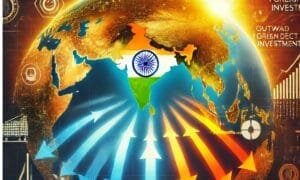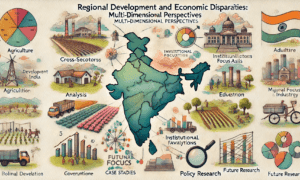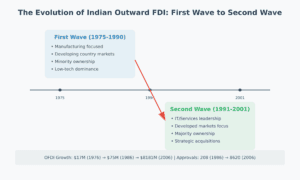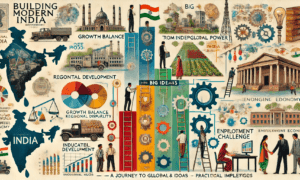A Global Economic Shift Something remarkable has been happening in the global business landscape – companies from emerging economies like China, India, and Brazil are increasingly becoming major international players. While emerging market companies have been investing abroad since the 1970s, today’s expansion is different in both scale and sophistication.
The Three Waves of Global Expansion The evolution of emerging market multinationals can be viewed as three distinct waves:
- Wave 1 (Pre-1985): Early pioneers making modest regional investments
- Wave 2 (1985-1995): Growing internationalization but still limited in scope
- Wave 3 (1995-Present): Dramatic expansion and increasing sophistication
By the Numbers: A Growing Force The scale of this transformation is striking:
- EMNCs’ foreign investments grew from $12 billion in 1990 to over $340 billion in 2008
- Their share of global foreign investment rose from 5% to 18%
- By 2007, EMNCs were investing about 10% of their capital formation abroad – a nine-fold increase from 1990
The BRIC Stories: Different Paths to Global Markets
Each major emerging economy shows distinct patterns:
China:
- State-owned enterprises leading the charge
- Strong focus on securing natural resources
- Investment doubled to $52 billion during 2007-2008 despite global crisis
- Government policy actively supporting international expansion
India:
- Primarily private sector-driven
- More diverse sectoral focus
- More market-oriented approach
- Investments reached $16.7 billion in 2008
- Strong presence in IT, pharmaceuticals, and manufacturing
Russia:
- Late entrant but aggressive growth
- Dominated by natural resource companies
- Focus on neighboring countries
- Largely private sector-led except for energy giant Gazprom
Brazil:
- Moderate but steady growth
- Significant investments through tax havens
- Mixed private and state ownership
- Strong in natural resources and manufacturing
Key Success Factors The rise of EMNCs has been driven by:
- Home country economic liberalization
- Growing technological capabilities
- Access to global capital markets
- Strong domestic growth providing financial strength
- Increasing global competition forcing international expansion
Looking Ahead: Implications This trend has significant implications for:
- Global competition and industry consolidation
- South-South economic cooperation
- Transfer of technology and management practices
- Development of emerging economies
Practical Takeaways For Business Leaders:
- Watch for emerging competitors from unexpected places
- Consider partnerships with EMNCs for market access
- Understand different strategic motivations of EMNCs
For Policymakers:
- Develop frameworks for managing increased EMNC investment
- Balance national security with economic openness
- Support domestic companies’ international expansion
Academic Abstract:
Purpose: The purpose of this paper is to present a framework for analyzing home and host country determinants and outcomes of emerging multinationals (EMNCs).
Design/methodology/approach: The paper applies a conceptual approach combined with analyses of statistics and secondary material.
Findings: The paper identifies changing trends and features of outward foreign direct investment (OFDI) from emerging economies and identifies in particular differences between outflows from Brazil, Russia, India, and China (BRIC). Originality/value: The paper puts forward a framework for analyzing determinants and outcomes of structures and strategies of multinational companies from emerging economies and surveys contemporary trends and features of outward FDI from these economies.
Learn More:
Full citation: P. Gammeltoft, Jaya Prakash Pradhan and A. Goldstein (2010), ‘Emerging Multinationals: Home and Host Country Determinants and Outcomes’ (with ), International Journal of Emerging Markets, 5(3/4), pp. 254–265, Publisher: Emerald Group Publishing.
Learn More:





































